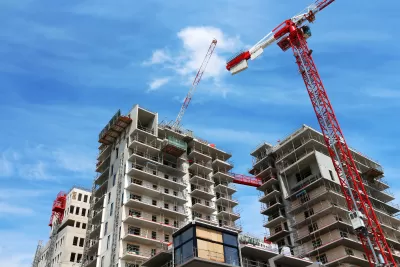Despite a strong belief in market forces in many other aspects of the economy, many Americans don’t see a correlation between housing supply and housing costs.

Writing in New York Magazine, Eric Levitz points out the odd breakdown of the “comprehension of the relationship between supply and affordability” when it comes to the way many Americans think about housing.
If the government tightly limited the production of sneakers, thereby triggering a bidding war over scarce athletic footwear, few would question whether the state’s deliberate suppression of shoe manufacturing was implicated in rising sneaker prices.
But “A 2022 study from political scientists in the University of California system found that a majority of Americans do not believe that increasing the supply of housing makes it more affordable.”
While it’s true that new housing sometimes appears to lead to higher rents, “the reason why new construction sometimes correlates with rising rents is not that housing is a good unlike any other, such that the more of it you create the more expensive it becomes,” Levitz explains.
“Rather, the reason is that developers build new housing in response to rising demand.” If local regulations or NIMBY opposition blocks needed new housing from being built, prices will go up. “Thus the less new housing that gets built, the faster rents will rise in a booming city”—see Austin, Texas for a recent example.
Levitz counters the “popular idea that new market-rate housing can’t reduce rents for working people because private developers prefer to build ‘luxury’ properties instead of affordable ones,” writing that the high cost of new housing is largely due to high land costs, and “new buildings will absorb high-income renters, reducing demand (and thus rental prices) for older housing units.”
Ultimately, “We can’t fully resolve our housing crisis by unshackling the invisible hand. But widespread skepticism about the relevance of ‘supply and demand’ to the housing market is making the crisis worse.”
FULL STORY: Rent Growth Is Slowing (Where Housing Got Built)

Maui's Vacation Rental Debate Turns Ugly
Verbal attacks, misinformation campaigns and fistfights plague a high-stakes debate to convert thousands of vacation rentals into long-term housing.

Planetizen Federal Action Tracker
A weekly monitor of how Trump’s orders and actions are impacting planners and planning in America.

In Urban Planning, AI Prompting Could be the New Design Thinking
Creativity has long been key to great urban design. What if we see AI as our new creative partner?

Cal Fire Chatbot Fails to Answer Basic Questions
An AI chatbot designed to provide information about wildfires can’t answer questions about evacuation orders, among other problems.

What Happens if Trump Kills Section 8?
The Trump admin aims to slash federal rental aid by nearly half and shift distribution to states. Experts warn this could spike homelessness and destabilize communities nationwide.

Sean Duffy Targets Rainbow Crosswalks in Road Safety Efforts
Despite evidence that colorful crosswalks actually improve intersection safety — and the lack of almost any crosswalks at all on the nation’s most dangerous arterial roads — U.S. Transportation Secretary Duffy is calling on states to remove them.
Urban Design for Planners 1: Software Tools
This six-course series explores essential urban design concepts using open source software and equips planners with the tools they need to participate fully in the urban design process.
Planning for Universal Design
Learn the tools for implementing Universal Design in planning regulations.
Appalachian Highlands Housing Partners
Gallatin County Department of Planning & Community Development
Heyer Gruel & Associates PA
Mpact (founded as Rail~Volution)
City of Camden Redevelopment Agency
City of Astoria
City of Portland
City of Laramie





























